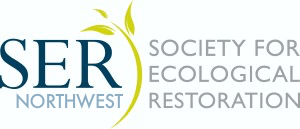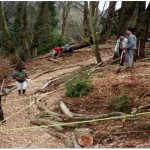Effective Restoration Stewardship by Joy Wood
There is no doubt that stewardship contributes greatly to the success of ecological restoration, especially in urban settings.1 Restoration that involves devoted stewards follows the Society for Ecological Restoration’s Four Guiding Principles in that it is an engaging and inclusive process whereby stewards engage with each other and the community. With provision of adequate continuing education, stewards can integrate knowledge and practice, in that their lessons learned can guide scientific questions regarding restoration, and stewards help to collect data and information (doing citizen science) that contribute to our restoration knowledge. Furthermore, stewards can come together to drive policy as many voices carry a unified message(s). And finally, stewards implement local actions that have regional and thus global benefits.
Stewardship may be defined as a person or team of people that have a vested interest such that they do relevant actions consistently over time to ensure the positive trajectory of a restoration project. Stewards invest not only a lot of their personal time and energy into their volunteer endeavors; they also put forth a lot of themselves into these efforts, and deserve to be consistently appreciated in return. Stewards work out of love for the job of being a steward, and their belief in what they do as stewards.2 In these times of fiscal limitations, non-profit organizations and municipalities alike, must rely increasingly on volunteers and stewards to achieve their goals.3 This, in turn, increases the risk of them feeling taken advantage of. At the same time, the budgetary constraints also limit the time and resources that organizations have to show volunteers sufficient appreciation and respect. It is important to acknowledge the diversity of stewards by education, ages, occupations, motivations, backgrounds, and affiliations, and to clearly demonstrate gratitude for their work, ambitions, and devotion to the restoration program. It is possible to recognize stewards in deep and meaningful ways, without breaking the budget by generating and nurturing a culture of gratitude and acknowledgement.
According to David C. McClelland’s Motivational Theory, there are three types of motivation that guide volunteers: achievement, affiliation, and influence.2 The “achievement”-driven steward is very goal-oriented, and likes to see data on progress, or information indicating program and personal accomplishments. Along the “affiliation” path lays the team-oriented steward that likes to hear “thank you”, and enjoys interaction with fellow stewards. Finally, the “influence” steward is vision-oriented, and likes to see their ideas implemented. Most volunteer stewards possess a mix of these characteristics; and it is possible to implement actions to recognize all three types of motivations simultaneously. In order to reach achievement-stewards, it is necessary to emphasize and supply evidence that the work is meaningful. To touch affiliation-stewards, say “thank you” in numerous ways, all the time, and at every opportunity. Finally, to appreciate influence-stewards, allow these stewards to take on increasingly more responsibility.2 In all, the important lesson to remember is to thank stewards in the way that they want (and need) to be thanked.
Organizations should build on-going, consistent, natural displays of gratitude. Offering continuing education is a good way both to show appreciation. It keeps stewards engaged in this field of their interest, and also gives them a platform upon which to build bonds with each other. Education also enhances stewards’ experience in working with community volunteers, in the messages that they convey at work parties to engage the community. Stewards already possess an active and perpetual interest in restoration, but it can take years to convey such a message to establish trust and build the bonds necessary to bring back and retain volunteers. Furthermore, it is beneficial to stewards and organizations to offer continuing education opportunities whereby stewards can not only learn new restoration techniques and theories. Consequently, stewards would likely not only stay more connected to the umbrella organization, but also to each other, which only enhances and benefits their interactions with community volunteers.
It is important to give stewards at least some autonomy in running and selecting their volunteer activities.1 Stewards are all too often the invisible constituents of the organization that are affected by top-down decisions, but are rarely consulted.2 They have constructive ideas and would like to share about how programs could run more effectively. If such an approach is to be implemented, the stewards must be kept up-to-date with regular reports that highlight steward achievements, challenges, and perspectives.2 Also, it is imperative to keep open lines of communication with stewards so that they fully understand any resource limitations. Stewardship can also mean participating in the science of restoration ecology. Whether it is collecting specific data or photo points over time, stewards can participate in citizen science, gathering baseline ecological data and monitoring information for years later.
The importance and benefits of stewardship to achieve ecological restoration through community engagement is well known and documented. The principal finding of a 2017 publication is that stewardship is the most important factor in determining the overall success of restoration projects in a suite of projects studied – as measured by the statistically significant increase in native plant species cover, richness, and diversity, improved site conditions, and reduction in invasive vegetation.1 How we reciprocate to stewards matters greatly in various ways to respect stewards’ abilities and commitments, by giving back to the people that give so much of themselves to enhance the success of urban restoration projects.
References:
- Wood, J. K., Gold, W. G., Fridley, J. L., Ewing, K. & Niyogi, D. K. An Analysis of Factors Driving Success in Ecological Restoration Projects by a University-Community Partnership. Ecol. Restor. 35, (2017).
- Morris, M. Building Strong Volunteer Programs. in Volunteer Recognition: The Art of Saying Thank You (ed. Washington Non-profits) (2017).
- Shandas, V. & Messer, W. B. Fostering Green Communities Through Civic Engagement: Community-Based Environmental Stewardship in the Portland Area. J. Am. Plan. Assoc. 74, 408–418 (2008).

